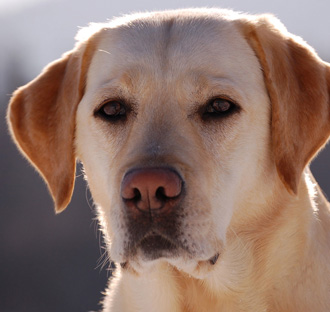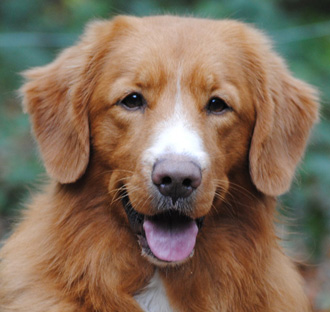 Chesapeake Bay Retrievers
Chesapeake Bay Retrievers
The word that seems to be used most often to describe the Chesapeake Bay Retriever is “powerful.” To quote from the breed standard, “[e]qually proficient on land and in the water, the Chesapeake Bay Retriever was developed along the Chesapeake Bay to hunt waterfowl under the most adverse weather and water conditions, often having to break ice during the course of many strenuous multiple retrieves.” They are happy and intelligent dogs. They differ from some of the other retriever breeds by being more protective and more loyal to their families. Chessies were developed for their temperament and their working ability and their appearance has always been less important to their fans. This is illustrated by the breed standard description of acceptable colors: brown, sedge, or deadgrass! The other retriever breeds have comparatively peppier names to describe their brown dogs. Chessie fans just don’t care about such trivial things. Chessies have very distinctive eyes that must be yellow or amber in color and that immediately distinguish them from their chocolate or liver retriever cousins.
Chesapeake Bay Retrievers have the reputation of being single minded as compared to other retrievers. They do best with owners who are experienced dog owners and who are willing to devote the time and energy to train these intelligent dogs.
 Curly Coated Retrievers
Curly Coated Retrievers
Curly Coated Retrievers are the most uncommon of all the retriever breeds, ranking the 130th most registered breed in 2005. However, their fans make very clear that Curlies are unique among retrievers for their grace and elegance in combination with their interminable ability to perform in the field. Upon first glance, what sets them apart from all other breeds is their unusual coat, which consists of small, tight, crisp curls. As described by the breed club, “[t]he Curly is wickedly smart and highly trainable and, as such, is cherishe/hed as much for his role as loyal companion at home as he is in the field.” Curlies are self-confident and proud dogs. They are more independent and less demonstrative than some of the other retriever breeds.
 Flat Coated Retrievers
Flat Coated Retrievers
Flat Coated Retriever fans are very proud of how few people actually know about their breed! They have taken pains to preserve the both the breed’s looks and its purpose. Unlike most other retriever breeds, having flat coats with titles in both field events and conformation (looks) is not unusual. These dogs are supposed to be able to go directly from the field to the show ring to the family room without faltering. Despite how versatile this breed is, they are a well-kept secret and the breed fanciers want to keep it this way.
This is an active breed. Individuals who think they should look into getting a flat coat because of its extraordinary good looks quickly find that breeders expect their puppies to go to people who will commit to a few hours of strenuous exercise a day, plus lessons in obedience, field work, and perhaps agility or other dog sports to kept the dogs healthy and mentally stimulated. Flat coats are cheerful and lighthearted, despite being exceptionally committed hunting dogs.
 Golden Retrievers
Golden Retrievers
Golden Retrievers are friendly, confident, and trustworthy. They are not supposed to be aggressive toward other dogs and definitely not toward people in normal situations. They make horrible watch dogs as they seem to believe every stranger is just a person they have not yet met, and perhaps there are treats in those pockets. Goldens come in every color from almost white to a deep red. Their energy level varies, with some wanting to retrieve nonstop and others wanting to sleep on the couch. All of them have a high desire to please their people. Goldens are often goofballs, so living with one or more of these dogs can be very entertaining. Because they are large dogs and because they have lots of hair, some people think they would do best as outside dogs. Instead, these dogs thrive on human companionship and on being part of the pack that includes their people.
 Labrador Retrievers
Labrador Retrievers
There are many good reasons why the Labrador Retriever is the most popular dog in the country! They are beautiful dogs with a friendly expression and they want to do what they can to please their people. They are smart and sturdy, dependable and resilient, forgiving and loving. They are known for their gentle, stable temperaments. Labs can be very active or more sedentary, depending on their lines. They are versatile dogs who enjoy doing any number of activities, especially if these are conducted with their people.
Labs are muscular dogs who come in only three colors: black, chocolate, and yellow. For some reason, individuals have focused on breeding Labradors of other hues and selling them as designer dogs. The three accepted colors are all beautiful and come in various shades, so additional colors are unnecessary!
 Nova Scotia Duck Tolling Retriever
Nova Scotia Duck Tolling Retriever
Nova Scotia Tolling Retrievers are the smallest of the retriever breeds. Tollers can be more leery with strangers than the other retriever breeds, but they tend to read their people’s reactions to the strangers and will relax and be welcoming if they see their owners do the same. They are curious about other animals and should never be aggressive. Tollers are very intelligent and happy dogs. They are happiest when working in any endeavor, but they bore quickly when faced with repetitive lessons. When training sessions are short, fun, and include new experiences, they learn very quickly. Tollers are adorable dogs and they perform field work in a very unique way. Their comic antics tend to attract the attention of ducks, thereby bringing the birds into position for their handlers. This is known as tolling and explains the source of their name. Tollers are the most recently developed breed among the retrievers.
 Retriever Mixes
Retriever Mixes
While many mixed breed dogs are born due to accidental breedings, there are a number of programs that seek to combine the best of each breed. We do not condone breeding unless done by reputable breeders for the purpose of improving the breed. However, many service dog programs are now purposely breeding Golden/Lab crosses. They have found that this particular combination results in dogs who are stronger than the average Golden and better able to perform the duties required of service dogs than the average Lab! For whatever reason, Lab/Golden crosses are common among accidental breedings and rescue often is offered some of these dogs. We have found that they are generally fantastic dogs with sound temperaments and beautiful physiques. Other combinations of retriever crosses have produced gorgeous, sweet, highly desirable dogs. Chessie/Lab crosses are not uncommon and are generally wonderful dogs.





